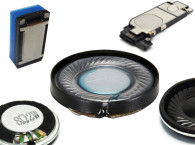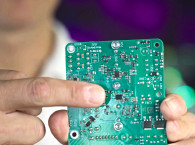
Over the years, for many phone designs screen sizes became larger — but the audio experience hasn’t always kept up, especially while in “loud” speaker mode. As a result, more high-end phones are offering stereo as an added feature, often with a microspeaker positioned at the top and the bottom. Now, when users turn their stereo-enhanced mobile phones on its side for viewing (i.e., landscape view), there is a speaker on either side to help create a better “stereo” listening experience.
This trend toward stereo audio in smartphones, and other audio-playing devices, shows that audio amplifiers are playing a more important role in smartphone design. As a result, audio amplifiers are seeing a big jump in both unit volume and technology (see Figure 1). According to SAR Insight & Consulting’s “The Global Market for Standalone Speaker Amplifiers,” market growth report, “Market shipments for audio amplifiers have grown 3× from 2010 to 2018, due not only to the increasing shipments of audio playing devices but also the increasing number of channels per device.”[1]
The report also states that stereo speakers have become widely used in the high-end smartphone market (phones priced above $550), especially since the 2016 introduction of stereo in the iPhone 7 mobile digital device. Since then, many other flagship smartphones have adopted stereo speakers in their products as well. The analyst firm also expects stereo sound to extend into mid-tier phones (defined as those between $200 and $500) estimating that nearly 600 million amplifiers shipped for use in the mid-tier market in 2018, with an anticipated rise to almost 700 million by 2023.

Growing Importance of Boosted Audio Amplifiers
However, the sweeping trend to include stereo in smartphones does not necessarily ensure a high-quality audio experience. For this to happen, the microspeakers should also be accompanied by a smart-boosted audio amplifier, which enables driving the speaker to maximum loudness while protecting the speaker from damage.
Smartphone audio designers should ensure a better, louder, clearer audio sound with the use of high-voltage audio amplifiers, speaker monitoring analog-to-digital converters (ADCs), and advanced algorithms that keep microspeakers within their safe operating conditions. Also, two speakers naturally mean two amplifiers. So size, efficiency, battery current management, and audio performance are twice as important. Thus, as smartphones go stereo, the role of the previously unheralded audio amplifier is becoming more elevated.
A design checklist to ensure you get the most from your smart-boosted audio amplifiers includes:
• Size — Board space is always a premium when packing features into a portable device, and one option is for two microspeakers to be placed at the top and bottom of the phone. Audio amplifiers must be smaller and more integrated, especially now that there are two. To address the size issue, Cirrus Logic used 55 nanometer technology to design its newest CS35L41 smart-boosted amplifier with DSP, making it easier for OEMs to incorporate a two-speaker design without sacrificing space for other new features.
• Power Efficiency — The SAR Insight & Consulting study also confirms that Class D has all but replaced Class-AB amplifiers in many markets due to the increased efficiency of Class-D audio amplifiers. However, even more power efficiencies can be achieved in the design. For example, the 11-V boosted Class-D amplifier from Cirrus Logic also uses a Class H DC-to-DC converter to boost the supply with higher efficiency over Class G, while additional battery management systems predictively adapt to changing audio, speaker and battery conditions to regulate battery current and save power. This underscores the changing technology and “boosted” role of the boosted audio amplifier (see Figure 2).
• Speaker Protection — According to SAR Insight & Consulting, the use of speaker protection algorithms from an embedded DSP within the amp has become more common in a number of applications where small form factor speakers are used (e.g., smartphones). These algorithms enable higher output without damaging the speaker. For example, the Cirrus Logic audio amplifier pushes over 5 W of power to a speaker rated at 1 W. This newer class of boosted audio amplifiers can push the power needed for higher excursion to produce louder, clearer audio, especially over speakerphone, without damaging the ultra-small micro speakers. SAR Insight’s report further states that “the use of speaker protection in mid-range smartphones has grown rapidly from 2013 as OEMs look to maximize speaker performance and use this alongside other enhancements (e.g., high-end CODECs) to differentiate their designs.”
• Audio Enhancement — Even with all these features, not all audio enhancement is created equal. To produce better clarity and enhanced stereo audio to match those vibrant, larger screens and visual content, advanced algorithms within an integrated DSP should also address audio design issues (e.g., equalization, compression and psychoacoustic enhancements to fine tune audio playback).

As users cut the cord on more traditional cable or satellite TV viewing and play more untethered content, smartphones and other mobile devices are fast becoming a primary platform for streaming and enjoying content. To match the clearer and brighter visual experience, more and more phones are moving away from single channel, or mono audio design, to two-channel stereo to offer a better listening experience. As this trend continues, the need for smart power amplifiers is becoming more critical. This means smartphone OEMs will not only look for space savings but also improved power efficiency and audio clarity, in both headphone and speakerphone modes, to differentiate their products. aX
References
[1] Information taken from the SAR Insight & Consulting FOCUS on Audio Power Amplifiers: Market Growth, Channel Count, Amplifier Types, Input Type, Class, Speaker Protection; Principal Analyst Peter Cooney, published 4Q 2017 and updated data from SAR Insight & Consulting’s Audio Signal Chain ICs Forecasts DATAbase in 1Q 2019.






